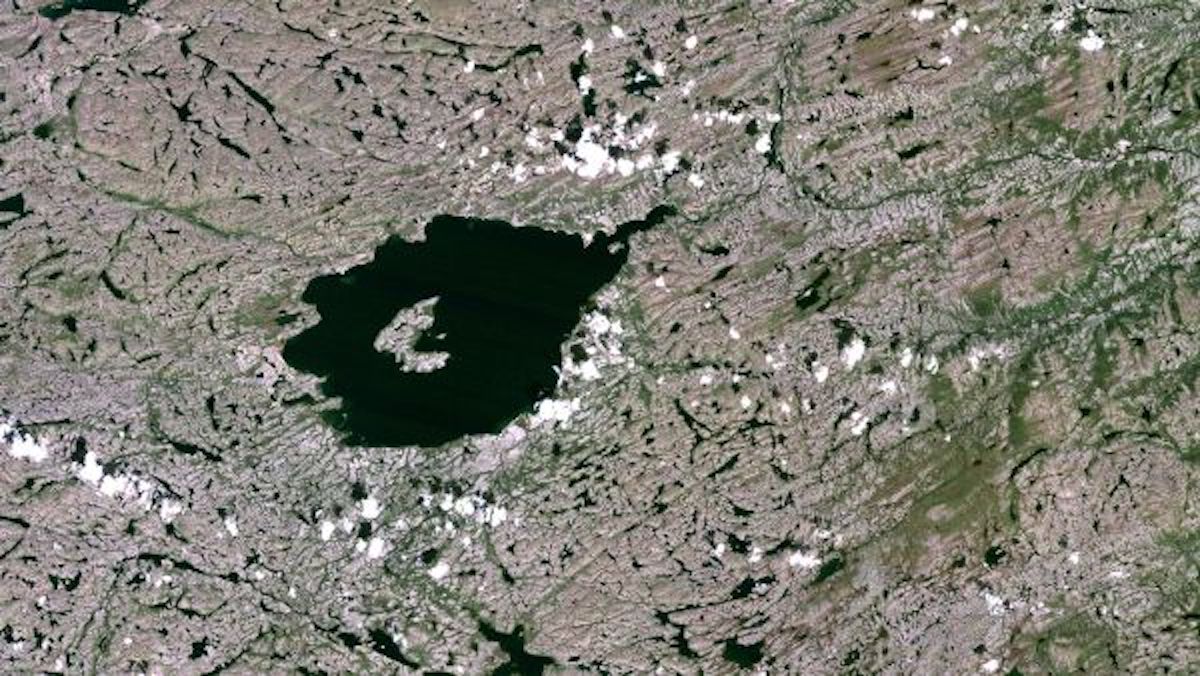Massive meteorite impact created the hottest mantle rock ever
The meteorite sizzled rocks some 36 million years ago.

It's confirmed: The hottest rock ever discovered in Earth's crust really was super-hot.
The rock, a fist-sized piece of black glass, was discovered in 2011 and first reported in 2017, when scientists wrote that it had been formed in temperatures reaching 4,298 degrees Fahrenheit (2,370 degrees Celsius), hotter than much of the Earth's mantle. Now, a new analysis of minerals from the same site reveals that this record-scorching heat was real.
The rocks melted and reformed in a meteorite impact about 36 million years ago in what is today Labrador, Canada. The impact formed the 17-mile-wide (28 kilometers) Mistastin crater, where Michael Zanetti, then a doctoral student at Washington University St. Louis, picked up the glassy rock during a Canadian Space Agency-funded study of how to coordinate astronauts and rovers working together to explore another planet or the moon. (Mistastin crater looks a lot like a moon crater and is often used as a stand-in for such research.)
The chance find turned out to be an important one. An analysis of the rock revealed that it contained zircons, extremely durable minerals that crystallize under high heat. The structure of zircons can show how hot it was when they formed.
Related: 10 Earth impact craters you must see
But to confirm the initial findings, researchers needed to date more than one zircon. In the new study, lead author Gavin Tolometti, a postdoctoral researcher at Western University in Canada, and colleagues analyzed four more zircons in samples from the crater. These samples came from different types of rocks in different locations, giving a more comprehensive view of how the impact heated the ground. One was from a glassy rock formed in the impact, two others from rocks that melted and resolidified, and one from a sedimentary rock that held fragments of glass formed in the impact.
The results showed that the impact-glass zircons were formed in at least 4,298 degrees Fahrenheit heat, just as the 2017 research indicated. In addition, the glass-bearing sedimentary rock had been heated to 3,043 degrees F (1,673 degrees Celsius). This broad range will help researchers narrow down places to look for the most super-heated rocks in other craters, Tolometti said in a statement.
Get the Space.com Newsletter
Breaking space news, the latest updates on rocket launches, skywatching events and more!
"We're starting to realize that if we're wanting to find evidence of temperatures this high, we need to look at specific regions instead of randomly selecting across an entire crater," he said.
The researchers also found a mineral called reidite within zircon grains from the crater. Reidites form when zircons undergo high temperatures and pressures, and their presence allows the researchers to calculate the pressures experienced by the rocks in the impact. They found that the impact introduced pressures of between 30 and 40 gigapascals. (Just one gigapascal is 145,038 pounds per square inch of pressure.) This would have been the pressure at the edges of the impact; at the zone where the meteorite hit the crust directly, the rocks would have not just melted, but vaporized.
The findings can be used to extrapolate to other craters on Earth — and elsewhere. The researchers hope to use similar methods to study rocks brought back from impact craters on the moon during the Apollo missions.
"It can be a step forward to try and understand how rocks have been modified by impact cratering across the entire solar system," Tolometti said.
The new study was published April 15 in the journal Earth and Planetary Science Letters.
Join our Space Forums to keep talking space on the latest missions, night sky and more! And if you have a news tip, correction or comment, let us know at: community@space.com.

Stephanie Pappas is a contributing writer for Space.com sister site Live Science, covering topics ranging from geoscience to archaeology to the human brain and behavior. She was previously a senior writer for Live Science but is now a freelancer based in Denver, Colorado, and regularly contributes to Scientific American and The Monitor, the monthly magazine of the American Psychological Association. Stephanie received a bachelor's degree in psychology from the University of South Carolina and a graduate certificate in science communication from the University of California, Santa Cruz.










